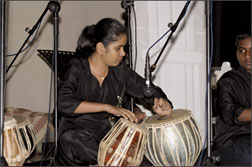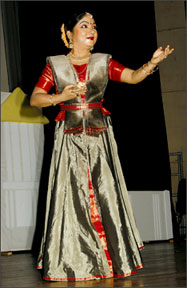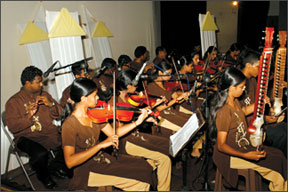Convergence of jewels of tradition and talent
Sharada Sangeeth Sanghitha:
by Indeewara Thilakarathne and Ranga Chandrarathne
[email protected]
|

An accompanying instrument used for an orchestra.
|
The evening of classical music titled ‘Sharada Sangeeth Sanghitha’
which was recently held at the Elphinstone Theatre to mark the 25th
Anniversary of the Sharada Kala Nikethanaya, was a rare occasion where
multiple talents of diverse traditions converged in harmony to make
auditory feat.
It was the talented students of the Kala Nikethanaya and veteran
musician Anil Mihiripenna who is also the founder of the Kala
Nikethanaya (a school of music), who took the audience on an exploration
of not only the diverse musical traditions such as Gazal and into the
interior of the three palaces of Prince Siddhartha; Ramya, Suramya and
Subha through an instrumental explanation but also into the fascinating
facets of Kathak dance.
Perhaps the most significant item of the concert was the Kathak dance
performance by visiting Indian academic Prof.Mandavi Singh.
The Kathak performance which mesmerised the audience, offered a
glimpse of rich artistic legacy of India and a rare chance for Sri
Lankan art-lovers of witnessing an authentic Kathak recital.
|

Genuine art from Madhya Pradesh - Prof. Mandavi Singh’s
brilliant Kathak performance |
The Concert commenced with Handavahini, a song composed in Sanskrit
which was sung to the music score created by Anil Mihiripenna.
Significant aspect of this music composition is the creation of the
Ragic atmosphere though the composition is not based on a particular
raga.
The next was the Kathak dance titled Navdurga Pradurbhava which was
choreographed by Duleeka Wickramasinghe. Nruthiya Vandana (Bharata
Natyam) choreographed by Weerasingham Wijendran was based on Radha-Krishna,
the famous story of romance in India. It should be mentioned here that
choreographer Weerasingham Wijendran is a talented dancer who had proved
his mettle.
One of the important items of the concert was the Gazal sung by
Sujith Priyadarshana. Gazal is a song composed in Urdu language.
Vocalist will find it extremely difficult to sing a Gazal if he or she
does not posses a sound of knowledge of Urdu. Perhaps it would not have
been a difficult task for Sujith who earned a MA from the ITS University
in Kerala. Though it was a difficult tradition, Sujith was able to
attract the attention of the audience.
Kethaka Mahima (Orchestral) composed and trained by Saman Fernando
expressed the joy and feeling of abundance associated with the
harvesting festival. Being an agrarian society, harvesting is an
importance occasion which is celebrated throughout the villages in Sri
Lanka.
This composition was entirely derived from traditional folk melodies.
Group Song Khayal and Tarana by students of Sharada Kala Nikethanaya was
an exposition of these styles of songs. The Khayal (Imagination) and
Tarana is a composition without any wording. It primarily shows the
ability of a singer or group of vocalists. Tarana consists of incoherent
sounds which convey no meanings.
The group of vocalists who took part in this group song was trained
by Shantha Ramani Dias. This item showed the kind of rigorous practice
that Sharada offered for its students which helped the students to
achieve excellence. This item was followed by Udana, a special Tabla
orchestra.
It is rare that Tabla which is an accompanying instrument is used for
an orchestral. It was especially composed for Tabla by Nandana Wijerama.
One of the salient features of Tabla Orchestra was the participation of
women tablists. This was also one of the items that attracted the
attention of the audience.
Ramya (summer), Suramya (winter) and Shubha (Rainy season) was,
perhaps, the most innovative piece of the concert which was composed by
Anil Mihiripenna and conducted by Geeth Mihiripenna. This was
instrumental explanation of the life in the three palaces that king
Suddhodana built for his son Siddhartha.
The king wanted to occupy his only son in the three palaces which
were building for the three main seasons in India; the winter, summer
and rainy seasons. It was the intention of the king that his son should
always be happy without ever seeing the negative aspects of life.
|

Enthralling spell of classical music. |
So he employed beautiful maidens who were accomplished Kathak dancers
to please him. The music scores for this composition was made to reflect
the inherent characteristic of kind of music performed during these
seasons which acted as an anti-dote to ward off the negative aspects of
the particular season.
For Ramya, the music was composed to create the anti-summer
atmosphere. Same principle is applied in composing music for Suramya
(winter) and Shubha (rainy season). The most important item of the
concert was the Kathak dance recital, especially prepared for the
concert by Prof. Mandavi Singh who is one of the most famous Kathak
proponents in India.
A significant aspect of Kathak dance is its subtlety and the
attention that it attracted to footwork. Kathak is deeply rooted in
religious practice and was first performed to Vedic chants and
subsequently to religious songs in prabhand style. Keertans and Dhrupads
were incorporated into the dance in fifteenth century.
Characteristically Kathak dance recital commences in a slow speed and
progressed into the very fast speed towards the end of it. This recital
by Prof. Mandavi was marked for its perfect Tukras, a piece of dance
which lasted only for six or seven bars of the time scale.
Perfect Tukras is a salient characteristic of an accomplished dancer.
The hand behind the success story is none other than Anil Mihiripenna, a
versatile musician who founded Sharada Kala Nikethanaya. Anil has marked
his foots prints on the contemporary musical arena as a teacher of music
and a creator.
Among his outstanding creations of music score for ballet is illusion
which is based on ragas Kiravani and Pilu.His compositions outside the
Hindustani system of music such as The daughters of Mara, Puja and Deep
Thought amply demonstrate Anil Mihirippena’s unique creativity and sharp
insight into the subtleties of sounds.
Perhaps, his most famous music score which brought him universal
admiration is Peacock Dance which was created out of behavioral patterns
of the peacock and translating them into sounds.
For this score he has used the orchestral music as the basis. It was
performed by the Nebraska Symphony Orchestra in 1980 and 1997. One of
the significant aspects of Mihiripenna’s compositions is the
assimilation of western instruments and techniques such as Counterpoint
and harmony to enhance his creativity. This aspect could also been seen
in Ramya, Suramya and Shubha.
All in the entire concert offered rare pieces of Hindustani classical
music for Sri Lankan audience apart from celebrating the 25th
anniversary of the Sharada Kala Nikethanaya. The concert showed that if
chances were given, Sri Lankan students could excel in aesthetic
pursuits and are second to none in terms of their performances. |
